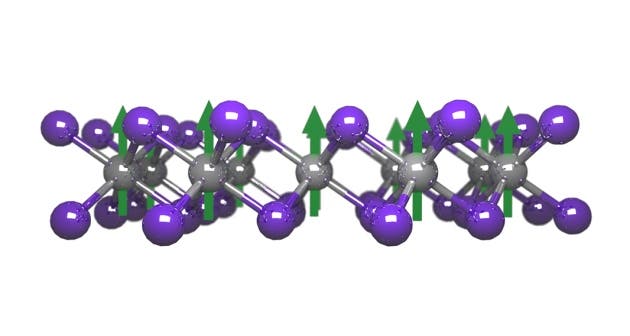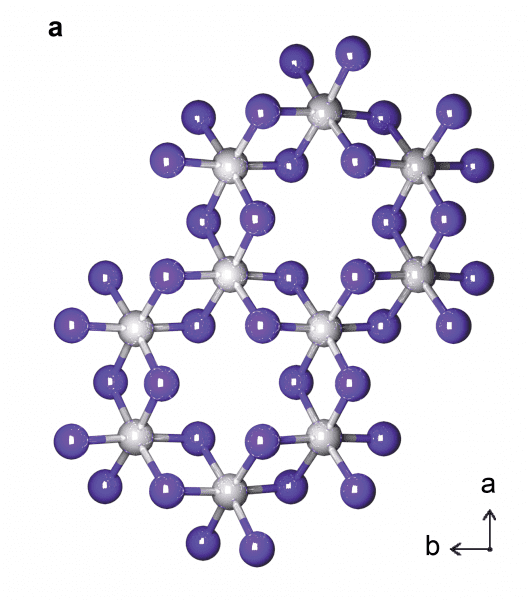Two decades ago, the notion of actually working in applied science with 2D materials was seen as a pipedream. But that all changed after graphene was first forged in Manchester, UK, in 2004. Since then, scientists have demonstrated one-atom-thick semiconductors, insulators, even superconductors. Now, a pair of talented physicists has completed the spectrum by adding magnets to the 2D family.

A 2-D layer of chromium triiodide atoms — the first single-sheet magnet in the world. Credit: Efrén Navarro Moratalla.
Up until this breakthrough study, scientists weren’t sure a 2D magnet was even possible. Here we are, though.
The discovery could ultimately lead to novel storage devices that work fundamentally different. Quantum computers might also benefit from this. Most of all, however, scientists working in fundamental physics will have their work cut out for them many years ahead as they now have the chance to perform experiments previously thought impossible. “It’s a matter of principle — there is a big thing missing,” Jarillo-Herrero told Nature.
Previously, the thinnest magnets were demonstrated by a group of Chinese researchers who worked with a crystal made of chromium, germanium, and tellurium. However, when the crystal was stripped to a single-atom layer, it lost its magnetic properties so not a real 2D magnet at all.
To build one, Xu and Jarilo-Herrero literally stripped a chromium triiodide (Crl3) crystal until all was left was a single-atom-thick layer. The reason why they choose this material was that it’s made of stacked sheets that can be separated easily using the so-called “Scotch tape method”, which literally means using adhesive tape to peel off layers off the larger, 3-D crystal form. The technique has been used to make graphene for some time. Secondly, chromium triiodide is ferromagnet (permanent magnet) and is also anisotropic, meaning it has physical properties which vary when measured in different directions. In our case, the material’s electrons spin perpendicular to the plane of the crystal. These were very good hints that suggested chromium triiodide could work as a 2D magnet.
By this point, it’s maybe important to mention what 2D actually means. It’s not the same as in, say, math where 2D means a completely flat plane. After all, this material is made of atoms and an atom is essentially 3D. Functionally, however, the atoms within the monolayer material are considered 2D because the electrons are confined to the atomic sheet, like pieces on a chessboard.
Layer by layer, the two physicists stripped chromium triiodide until it became 2D and low and behold it was magnetic. Moreover, this property arises at a relatively low temperature when working in the atomic domain: -228 degrees Celsius.

Top-view depiction of a CrI3 lattice. Cr atoms are in grey, I atoms are in purple. Credit: Efren Navarro-Moratalla.
Another interesting quirk was that when the material was comprised of two-layered sheets, it stopped being magnetic. They tested it by shining polarized light on the material, which returns a distinct signature in response to ferromagnetism. Adding another third sheet turned the material back into a ferromagnet and remained ferromagnetic when the fourth layer was added as well. The researchers are still investing why.
“2D monolayers alone offer exciting opportunities to study the drastic and precise electrical control of magnetic properties, which has been a challenge to realize using their 3D bulk crystals,” says Xiaodong Xu, lead author of the study, in a statement. “But an even greater opportunity can arise when you stack monolayers with different physical properties together. There, you can get even more exotic phenomena not seen in the monolayer alone or in the 3D bulk crystal.”
This is the culmination of more than five decades worth of searching for an ultrathin magnet. We now got more than anyone bargained for: a 2D magnet. But to be really useful, physicists would like to find a 2D ferromagnet that works at room temperature and ambient conditions, like in the presence of oxygen for instance. Jarillo-Herrero and Xu are currently exploring other magnets in chromium triiodide’s chemical family for clues.
Meanwhile, they also want to layer this 2D magnet with a 2D superconductor to see what happens.
“Does the superconductor destroy the ferromagnet, or does the ferromagnet destroy the superconductor?” Jarillo-Herrero told Nature. “It was just not possible to do this experiment before.”
“Heterostructures hold the greatest promise of realizing new applications in computing, database storage, communications and other applications we cannot even fathom yet,” said Xu.
The findings were reported in the journal Nature.









